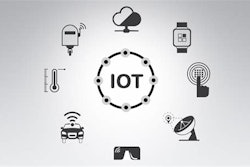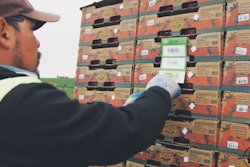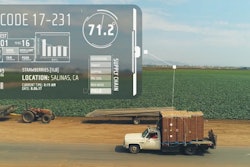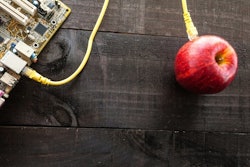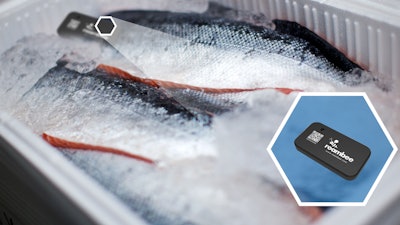
The Internet of Things (IoT) is an emerging technology filled with sensors, machine learning, artificial intelligence and analytics. IoT is being called upon to solve a plethora of problems in every industry. In the food and grocery industry, it is being looked at as a way to improve supply chain performance and profit margins by tracking food freshness and predicting and avoiding the spoilage of perishable foods.
At the same time, IoT is relatively early in its adoption at most companies. Few food and grocery companies have extensive experience with IoT, nor do they have the confidence that IoT enablement will save them money, reduce spoilage, improve times to market, transform supply chain management and increase customer satisfaction.
“IoT is about sensing and coding data so the data can yield greater insights,” says Terry Myers, CEO of Infratab, which provides perishable food tracking technology. “When it comes to perishable foods in particular, companies are concerned about shelf life, freshness and the condition of the food. All of these facts add up to one question: How is the food?”
Infratab’s solution uses freshness metrics that enable them to quantify shelf life and help identify the spoilage characteristics of each food item. Shelf life starts at 100 points and ends at zero points. For example, if the item is a peach, Infratab can measure shelf life for that item against timelines in the supply chain, based on the temperature a food must be kept at and the elapsed shelf life time. This enables companies to make supply chain decisions such as expediting shipments of certain goods to market.
Though the benefits seem obvious, the fresh produce industry is still lagging in comparison to other industries such as food and beverage, pharmaceuticals, and frozen foods, who have all made significant progress in adopting IoT.
“As the costs and size factors of IoT are trending downward, the value of information and how it can be used is increasing significantly,” says John W. Sammon III, senior vice president and general manager at ParTech Inc., which provides point of sale and food safety systems. “Nearly every week, we hear a familiar story from customers. They installed their IoT solutions, they became alerted in the middle of the night, they reacted, and they saved thousands of dollars of inventory, which would have been lost due to food safety risks. This is true whether the customer is a grocery, a C-store, a QSR restaurant, or a food contractor.”
In these companies, IoT technology is making a difference because of its capacity to monitor food throughout the supply chain and also to detect and/or predict the risk of spoilage for perishable foods.
“IoT is optimizing shelf life in several ways,” adds Sanjay Sharma, CEO of Roambee, an IoT smart logistics and asset monitoring company, which provides end-to-end real-time monitoring systems. “It can monitor the temperature, humidity and other environmental conditions of perishable foods and beverages as they go from one point to another point until they reach a consumer store. You can also use IoT to predict shelf life based on the anomalies of cold chain conditions over a given period by measuring the various gases and the environmental conditions through the ripening process and then fine tuning these to create ideal ripening conditions.”
Equally important, IoT can perform a certain amount of supply chain policing by using machine learning and artificial intelligence on data that is collected, and then assessing this data to identify transporters that present a greater risk of food spoilage based on their transportation and delivery records. Managers can take this data, and then meet with carriers so SLAs (service level agreements) can be established that hold the transporters more accountable.
Barriers to Adoption
Of course, to succeed with IoT in end-to-end monitoring of food for quality and spoilage, your network has to reach far beyond your own front door and into the networks of suppliers, transporters and retailers. Integrating information exchanges with all of these parties, which use a vast array of manual and automated systems in their own right, can be daunting.
“It is cumbersome for the following reasons,” says Sharma. “You have hardware and software vendors selling their own solutions, and then you have to find a system integrator to make all of these pieces fit together and interoperate. Additionally, many companies do not have onsite knowledge about how to develop strong RFPs and vet vendors so they can make a good vendor choice. Then on back end, you often have to fit the IoT solutions into the ERP system that you are using.”
Sharma suggests finding a provider who has a packaged solution that is inexpensive and that can be implemented in days without huge upfront investments.
Infratab’s Terry Myers agrees. “All of the IoT data that we collect at different local collection points is stored in the cloud. We collect our data from smart tags on foods that can be scanned by smart phones or tablets. Instantly, we know if a certain shipment of goods is in danger of spoilage, and we can notify the company so they can take action.”
Myers adds that IoT technology is gradually replacing traditional loggers, which have been in use since the 1960s. “These older devices were never integrated into supply chain systems, so they didn't facilitate much decision making. When the FDA introduced food touch and trace regulations, every perishable food that came into the country had to be monitored. New technology that could be integrated with supply chains was needed to facilitate that. Now, we use mobile devices, smart tags and cloud-based data repositories to capture and available the information.”
For food and grocery companies, the best news about keeping all of this information in the cloud is that it enables companies to limit their investments in on-premise hardware and software, and opens opportunities for simple mobile device use like smart phones that workers already have.
Moving Forward
Despite the move to cloud-based technologies, which has made IoT cheaper, overall adoption of IoT in the food and grocery industry is somewhere between early and middle stages—but it is far from mature.
“What we see is that most food and grocery companies have some form of sensing, but this is not in real time,” says Sharma. “A major challenge is getting the economics of IoT right so enterprises can experience instant ROI.”
Meanwhile, IoT has been aggressively adopted by large supermarket chains whose emphasis is on food quality and the performance of their supply chains.
“We are even seeing chip makers start to incorporate more sensors on their chips,” Myers observes. “But we still have people in the industry who like to work with the older loggers.”
Adds Sammon: “At the end of the day it’s really about the people. IoT technology itself is simplistic, but a culture of awareness and responsiveness is only achieved by training people to use the tools.”
One of the best ways to do this is through business use cases that IoT can immediately benefit.
“Use cases are arising because of the impact of climate change,” Myers says. “In the commercial fishing industry, the processes followed for processing fish on boats 20 or 30 years ago can no longer be used, because you can't keep the fish on board as long as in years past, as it require too much ice. Instead, you have to monitor the freshness of the fish and route it to packing houses much faster. Traditional loggers don’t work in this situation because they can't integrate with systems—and everyone involved in the process needs to be actively sharing data.”
In a second case, strawberry growers in California are feeling the impact of climate change because the warmer weather now has their growing season aligned with the growing season in Mexico. In Mexico, modern agriculture practices are in place and labor is much cheaper, so this makes it tough for California farmers to compete on price. To answer the challenge, California growers are trying to compete on the premise that their produce is fresher. They use sensor-based technology and monitoring to speed food to market.
Still, there are problems that IoT can't solve.
“The barriers are fundamentally the other projects that companies choose over IoT,” says Sammon. “These integrations require investments of time and dollars. The ROI is very good, but another technology may drive more revenue, and so difficult decisions need to be made. But the values are there, and the time for IoT is coming.”




